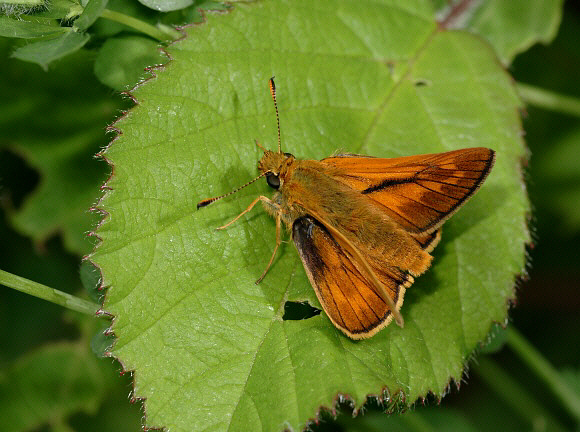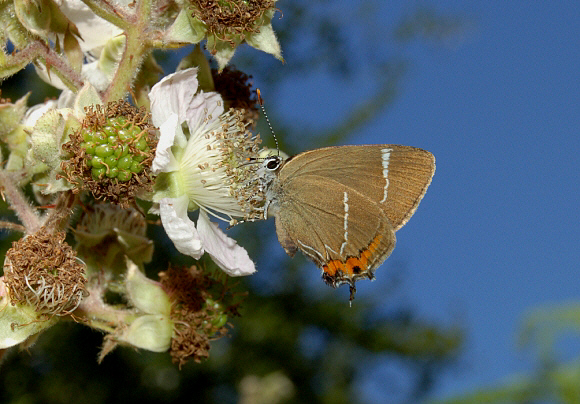
Large Skipper Ochlodes venata – Photographed by weak sunlight, in combination with the built-in flash unit. 18-55 zoom at closest focus, aperture priority metering, F16 – Adrian Hoskins
Choosing and using flash
Purists will always shoot using natural daylight but there are several reasons why it can often be better to shoot by flash or to use a carefully balanced combination of daylight and flash illumination.
Firstly, contrast levels in bright sunlight are often so high that it is a good idea to ‘fill-in’ the shadow areas with flash illumination, thereby lowering the overall contrast. Secondly, on warm sunny days butterflies can be very active, and the short duration of the flash ( about 1/2000 sec ) is better at freezing their movement. Thirdly, although the flash duration is short the light output is very high – brighter than sunlight at close distances. This means that apertures as small as F16 or F22 can be used, resulting in greater depth of field. Finally, there will be many situations such as in the interior of a rainforest, where conditions are so dark that it is virtually impossible to shoot by daylight.
There are of course a few disadvantages to using flash. No form of artificial lighting will ever look as natural as daylight. You can minimise the flash effect by using it as a fill-in rather than as the main source of illumination, but this can result in double shadows. The bulk and weight of a complex flash set-up can be cumbersome and slow you down. The biggest problem however is that the auto flash exposure systems of most cameras cause a pre-flash to fire a fraction of a second before the main flash. The pre-flash alarms the butterfly causing it to take flight, and results in a missed photo. Even if it doesn’t take flight the butterfly is likely to twitch its wings in reaction to the pre-flash, causing loss of sharpness. ‘Twitchy’ species are therefore best photographed by natural lighting.
Dedicated flashguns
Most modern flash units are ‘dedicated’, i.e. designed to operate exclusively with a particular brand of camera. The circuitry allows the camera and flash unit to communicate electronically, so that when the camera senses that flash illumination is necessary it automatically activates the flash unit and controls the duration of the flash burst to achieve the best exposure. Dedicated flash systems automatically set the correct shutter speed for correct flash synchronisation, and also transmit a ‘correct exposure achieved’ signal to the viewfinder. Additionally they usually incorporate a timer which turns the flash off after a few minutes to save battery power. In most cases it is possible to buy extension leads which retain the dedicated features even when the flash is used ‘off-camera’.
Auto flash exposure
Modern DSLR cameras meter the flash intensity either directly from the image plane, or from the focusing screen. In a split second the camera measures the strength of the flash light coming through the lens, calculates the variables such as aperture, subject distance and ISO setting, and then controls the duration of the flash burst to provide the correct exposure. Some systems work better than others, and it is often necessary to use exposure compensation if the subject is very pale, very dark, or if the background is some distance behind the subject.
Off-camera flash
Flash often produces unnatural results – butterflies can look like cardboard cut-outs, and reflections from the flash can make the wings look too shiny, particularly on older worn specimens that have lost a few wing scales. You can minimise the problem by using a flash mounted on a bracket at 45 degrees above and to the side of the camera.
This provides a more 3-dimensional lighting effect and eliminates the reflections, but tends to produce excessively dark shadows. You can improve the results by using the integral flash as a supplementary light to ‘fill-in’ the shadows.
Ring flash
A ring flash normally consists of a single circular flash tube which surrounds the lens. Some models have a different design, with either 2 or 4 tiny flash tubes built in to a housing that screws into the filter mount of the lens. Both types produce soft and virtually shadow-less illumination similar to that produced by daylight on an overcast day. Their devotees extol the virtues of soft lighting and ease of use, but the textures of the wing veins and scales, and of the foliage on which the butterfly is resting all tend to get lost, leaving a dull lifeless image. Ring-flashes are sold by Canon, Nikon, Sony, Pentax, Olympus, Sigma etc; and are dedicated to particular cameras.
LED ring-lights
Beware of ‘LED’ type ring flashes – these are not real flashguns, instead they use a continuous light source which will not freeze movement. Also they are very under-powered compared to a proper ring-flash, so the light will not be bright enough to allow the use of small apertures unless you use a very high ISO setting.
Twin-macro flash
Twin-macro flashes consist of a pair of small flash heads, mounted on a ring surrounding the lens. The flash heads are linked by cable to a ‘controller’ which sits in the camera’s hot-shoe. This lets the user choose between using auto-flash or manual output. In some cases it also allows each flash head to be set individually to fractional power settings.
Normal practice is to have one operating at full power to provide modelling and texture, and the other at half power to fill-in the shadow areas. The effect is usually quite pleasing. The flash heads can be set to a number of positions around the ring, and can be angled to point the light directly at any subject regardless of distance.
Balancing flash with daylight
The power of flash diminishes with distance, so consequently backgrounds receive less illumination than the foreground subject. This can result in a ‘taken at night’ look, but this is easily overcome by ensuring that the flash output and sunlight are balanced.
The easiest way to achieve this is to set the flash compensation to zero, and the daylight compensation to minus 1 stop. The subject is then correctly exposed by flash, while the background is rendered a fraction darker – enough to minimise any ‘ghost’ images, but still providing plenty of detail in the background.

White-letter Hairstreak Satyrium w-album – Shutter priority, 1/125 sec. Flash compensation zero, daylight compensation minus 1 stop – Adrian Hoskins
